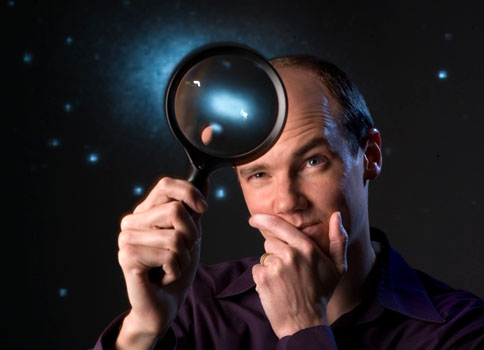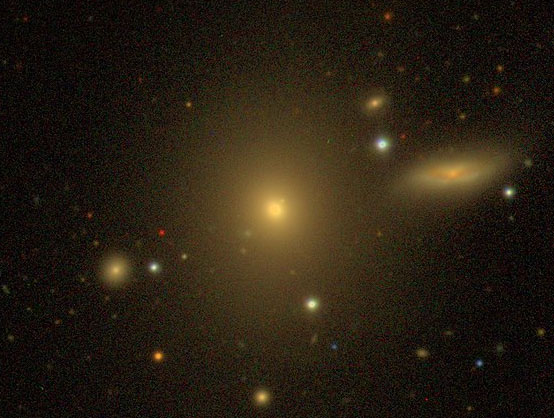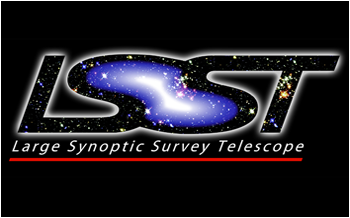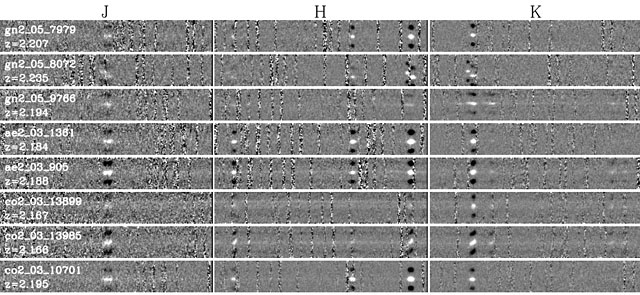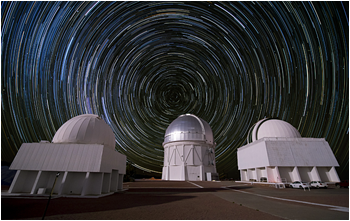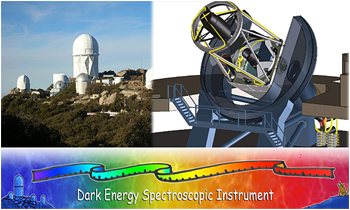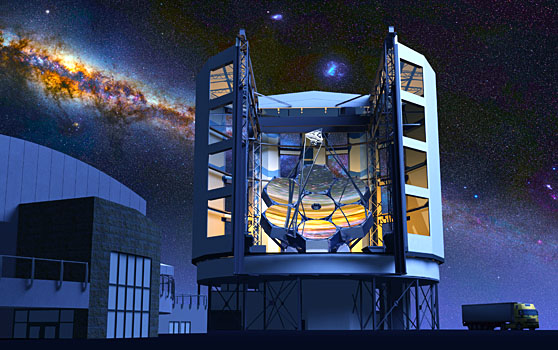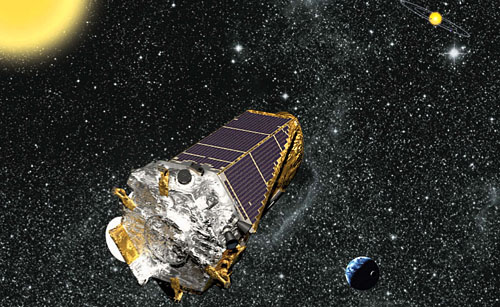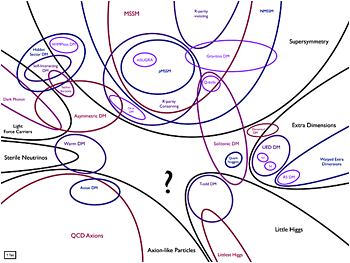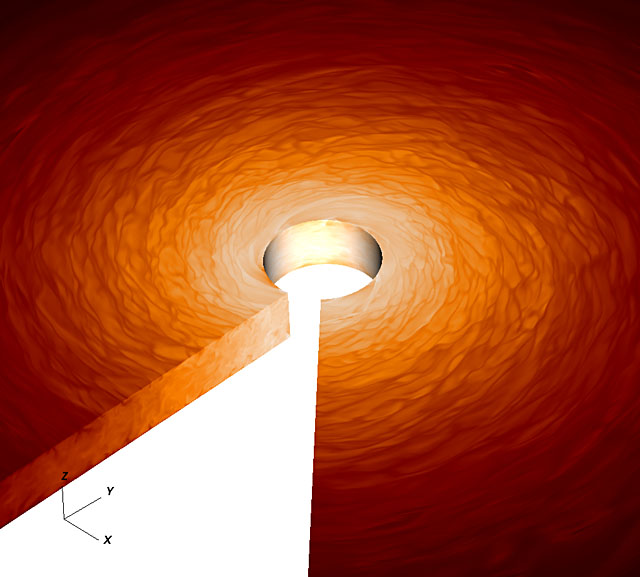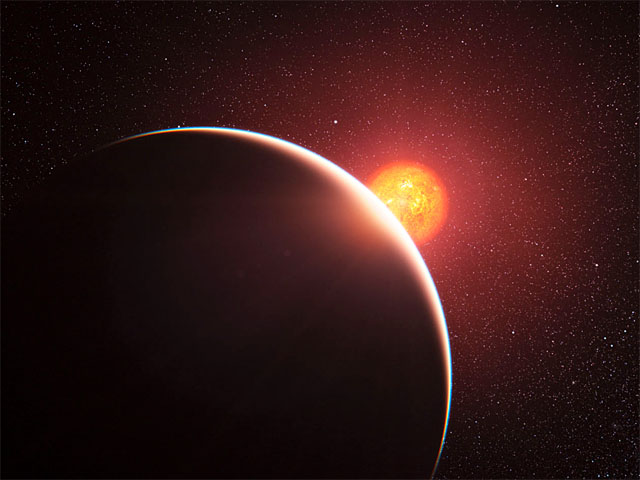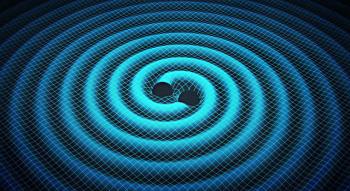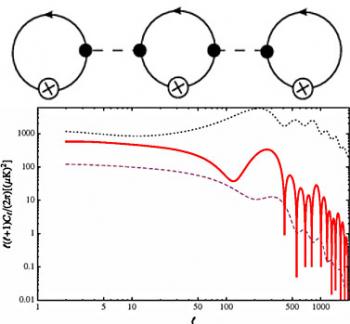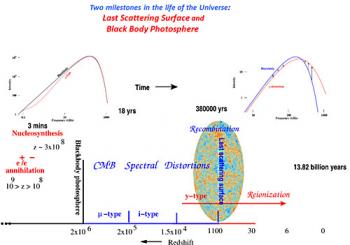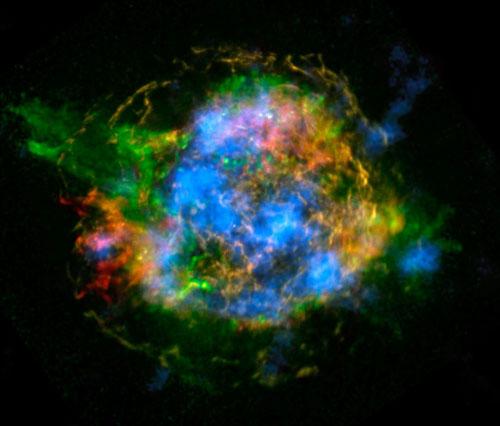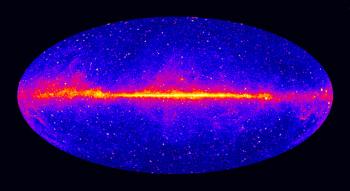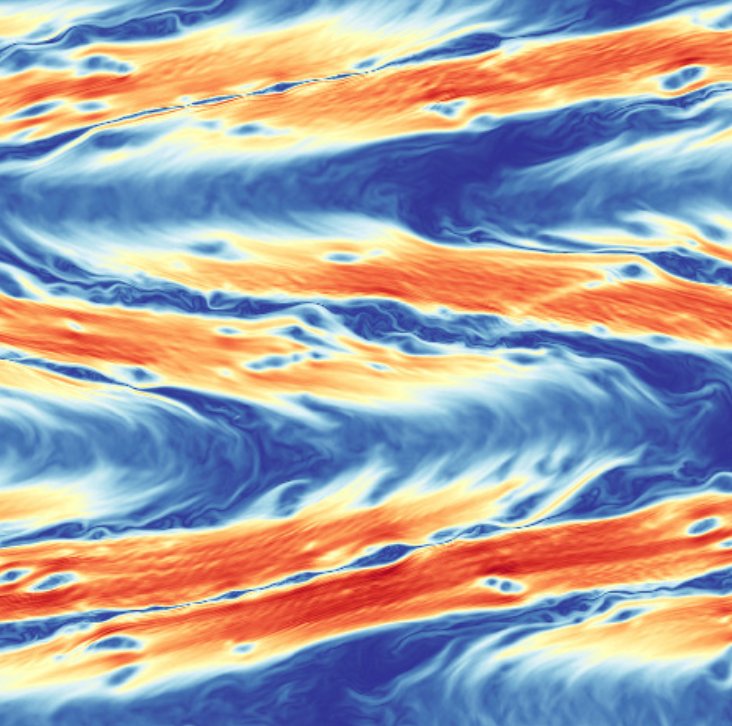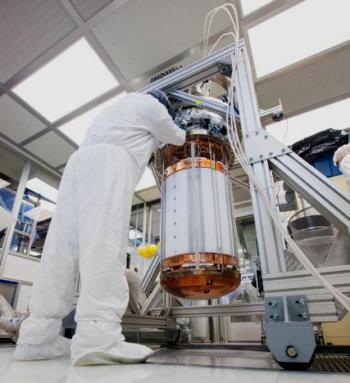 |
 |
 |
 |
 |
 |
 |
 |
 |
 |
 |
 |
|
Talks & Events
|
Colloquia: 2014
Dwarf Galaxies: The Nexus of Dark Matter and Chemical Evolution The Local Group's dwarf galaxies are near enough for exquisitely detailed, resolved stellar spectroscopy and diverse enough to conduct experiments on dark matter and chemical evolution. I have collected medium-resolution spectra for thousands of stars in many dwarf galaxies in the Local Group. Innovative techniques applied to these spectra recover velocities precise to a few km/s and detailed abundances precise to 0.1 dex. Although Milky Way satellites and field dwarf galaxies are different in many ways, their velocity dispersions show that both types of galaxy pose a serious challenge to cold dark matter. Both types also obey the same mass-metallicity relation despite the large diversity of star formation histories and detailed abundance ratios. From Reionization to Dark Matter with the Lyman-alpha Forest Absorption lines in the spectra of distant quasars offer one of the most powerful probes of cosmic structure. The Lyman-alpha forest traces the baryons in the intergalactic medium (IGM) over several decades in scale. The properties of the baryons, in turn, reflect the ongoing interaction between luminous objects and the IGM, as well as the nature of dark matter itself. I will present recent results from a suite of projects focused on determining some of the most basic properties of the high-redshift IGM, including its temperature, ionization state, and small-scale density structure. These measurements are providing new insights into when and how the IGM was reionized, the properties of high-redshift galaxies, as well as the viability of warm dark matter. I will also discuss how upcoming IGM studies with current and next-generation facilities will advance our understanding of these and other topics. To Build an Elliptical Galaxy I will discuss two essential aspects of elliptical galaxy formation: how they get their stars, and how they lose their gas. For the former, I use integral-field observations of local massive galaxies to study the stellar populations and kinematics of stars at large radius, to understand the origin of the size growth of elliptical galaxies. Then I focus on black hole feedback as a means of clearing gas from massive galaxies. I show that luminous obscured quasars have ubiquitous, round ionized outflows with very high gas dispersions of nearly 1000 km/s out to 20 kpc. Finally, if time permits I will combine these two themes and present our recent search for sub-pc supermassive black hole binaries. Direct Imaging of Extrasolar Planets With current technology, young (<100 Myr) planets can be directly imaged - resolved from their parent star - in the near-infrared with adaptive optics. I will discuss the first system of extrasolar planets to be imaged - the four planets orbiting the young F0 star HR8799. The outer two planets have been characterized spectroscopically using adaptive optics on the Keck telescope, showing non-equilibrium chemistry as well as evidence of composition enhanced in C/O from the original stellar nebula. The supply of young stars in the solar neighborhood suitable for such searches has been essentially exhausted. Providing a statistically significant sample of planets, and accessing Jupiter-like masses and separations, will require dedicated instruments. The Gemini Planet Imager is one such facility, combining advanced adaptive optics with a coronagraph and near-infrared integral field spectrosgraph. Designed to be an order of magnitude more sensitive than current instruments, GPI had first light in November 2013. I will present results here. The role of ultra-luminous galaxies in galaxy formation and evolution I will provide an overview of ultra-luminous galaxies (L_IR>10^12 Lsun) at high redshift, and the different roles and properties they appear to exhibit as a function of their luminosity. I will focus on the molecular gas properties of the galaxies as the crucial fuel available for star formation, emphasizing our recent work with ALMA and the IRAM Plateau-de-Bure, where we have studied galaxies preselected at various wavelengths, and conducted blind surveys for CO gas. I will conclude with wide field surveys that are uncovering the most extreme specimens of star forming galaxies in the universe, and point to future facilities which will push the field to a new level of understanding. Rest-frame Optical Spectra: A Window into Galaxy Formation at z~2 Rest-frame optical spectroscopy provides basic insight into the stellar and gaseous contents of galaxies. Until now, our knowledge of the rest-frame optical spectroscopic properties of galaxies at 1.5<=z<=3.5 has been extremely limited, despite the critical importance of this cosmic epoch for the assembly of galaxies and the growth of black holes. The recent commissioning of the MOSFIRE spectrograph on the Keck I telescope represents a major development for the study of the rest-frame optical properties of high-redshift galaxies. The MOSFIRE Deep Evolution Field (MOSDEF) Survey fully exploits the new capabilities of MOSFIRE, charting the evolution of the rest-frame optical spectra for ~2000 galaxies in three distinct redshift intervals spanning 1.5<=z<=3.5 -- more than an order of magnitude improvement over existing surveys. With MOSDEF, we address key questions including: What are the physical processes driving star formation in individual galaxies? How do galaxies exchange gas and heavy elements with the intergalactic medium? How are stellar mass and structure assembled in galaxies (in situ star formation vs. mergers)? What is the nature of the co-evolution of black holes and stellar populations? In this talk I will present early science results from the MOSDEF survey. Dark Energy Survey: Early Results The expansion of the universe is accelerating, a discovery that earned the 2011 Nobel Prize in physics. Is cosmic acceleration due to "dark energy," or do we need to modify Einstein's General Relativity? If it is a new form of energy, is it constant or changing in time? Addressing these questions is the primary goal of the Dark Energy Survey (DES). After achieving first light in 2012, followed by months of commissioning and science verification, DES has just completed its first season of science observations at the Blanco 4-meter telescope at the Cerro Tololo Inter-American Observatory in Chile. The DES Collaboration built a new 570-megapixel digital imager, the Dark Energy Camera (DECam), to carry out a deep, wide survey over the course of five (5) years---observing thousands of Type-Ia supernovae and hundreds of millions of galaxies. The thick, red-sensitive imager will allow us to see more supernovae and galaxies at higher redshift than previous surveys, like the Sloan Digital Sky Survey (SDSS). These observations will provide a suite of cosmological signatures: the Supernova Hubble diagram, galaxy cluster number counts, large-scale galaxy clustering and weak gravitational lensing. With this data, we will probe both the cosmic expansion history and the growth of large-scale structures, and thus explore the nature of dark energy. I will discuss the motivation for DES, the first years of operation and early results. News from the Extreme Energy Cliff Thanks to giant extensive air-showers observatories, such as the Pierre Auger Observatory and the Telescope Array, we now know that the sources of ultrahigh energy cosmic rays (UHECRs) are extragalactic. We also know that either they interact with the CMB as predicted or they run out of energy at the same energy scale of the CMB interactions! Their composition is either surprising (dominated by heavier nuclei at the highest energies) or the hadronic interactions at 100 TeV are not a standard extrapolation of LHC interaction energies. Hints of anisotropies begin to appear as energies reach 60 EeV, just when statistics become very limited. Basic questions remain unanswered: What generates such extremely energetic particles that reach above 10^20 eV (100 EeV)? Where do they come from? How do they reach these energies? What are they? How do they interact on their way to Earth and with the Earth's atmosphere? To answer these questions larger statistics at the highest energies is necessary. Space-based observatories can significantly improve the exposure to these extremely energetic particles. The first step to answer these questions is to place a wide field UV telescope at the International State Station to monitor the Earth's atmosphere from above. This is the goal of the JEM-EUSO mission: the Extreme Universe Space Observatory (EUSO) at the Japanese Experiment Module (JEM). A Tale of Two Collaborations: A New Precise Measurement of Cosmological Parameters Using Type Ia Supernovae The GMT Project: Science and Status In this talk, I will give an overview of the GMT project and the science cases and goals that are driving its design. I will also describe the current status of the project and the first generation instruments that are now under development. Do WIMPs Rule? The LUX Experiment and the Search for Cosmic Dark Matter CANCELLED The search for dark matter in the form of Weakly Interacting Massive Particles, or WIMPs, has been ongoing for nearly thirty years. Steady progress has been made through the development and use of novel particle detectors aimed at low energy threshold and low radioactive backgrounds. After touching on the cosmological and astrophysical underpinnings, I will discuss the experimental challenges in searching for WIMPs and how we are attempting to meet them with the LUX experiment. LUX, the Large Underground Xenon experiment, is a time projection chamber that uses 250 kg of liquified xenon as a WIMP target. The detector is housed in the Sanford Underground Research Facility at the former Homestake goldmine in South Dakota. I will report on the first science run, which was completed in 2013, as well as upcoming plans. I will also describe the proposed follow-up LZ experiment, to be carried out by a merger of the LUX and Zeplin-3 collaborations. Asteroseismology and Exoplanets: A Kepler Success Story Asteroseismology - the study of stellar oscillations - is a powerful observational tool to probe the structure and evolution of stars. In addition to the large number of newly discovered exoplanets, the Kepler space telescope has revolutionized asteroseismology by detecting oscillations in thousands of stars from the main-sequence to the red-giant branch. In this talk I will highlight recent asteroseismic discoveries by Kepler, focusing in particular on studies of exoplanet host stars and the application of asteroseismology to measure stellar spin-orbit inclinations. I will furthermore discuss current efforts to improve fundamental properties (such as temperatures, masses, and radii) of Kepler targets, and their importance for deriving accurate planet occurrence rates using the Kepler sample. Finally, I will give a brief overview on first results by Kepler's ecliptic plane follow-up mission, K2. Searches for Particle Dark Matter Dark Matter is all around us, a clear sign of physics beyond the Standard Model, and yet we will have not understood what it is and how it fits into the larger picture. In this talk, I will discuss what we know about dark matter and how different kinds of searches, including searches for its collision with heavy nuclei, production at accelerators, and signs of its annihilation in our galaxy, combine together to give us information about how it (doesn't) interact with ordinary matter. The picture that will emerge is one where different searches complement each other, offering rich opportunities to understand the nature of dark matter in the near future. Turbulence and dynamo action in accretion flows The most remarkable thing about accretion discs is that they accrete. The rate at which material can be accreted from a disc onto a central compact object is controlled by the rate at which angular momentum can be transported out of the disc. Thus efficient accretion requires efficient angular momentum transport, typically many orders of magnitude larger than what could be accounted by viscous processes alone. Consequently, it has long been assumed that astrophysical discs must be turbulent, and that the turbulence is what causes the enhanced transport. Yet, basic considerations indicate that discs with near-Keplerian velocity profiles should be hydrodynamically stable. Thus the accretion disc conundrum: how can a stable system be turbulent? One possible resolution is that, in an electrically conducting disc, the presence of a weak magnetic field drastically alters the stability property of the disc. A powerful, rapidly growing instability—the magneto-rotational-instability (MRI), can develop, lead to turbulence and efficiently transport angular momentum outwards. Better still, there is evidence that turbulence driven by the MRI can, through dynamo action, regenerate the very magnetic field necessary for the instability to develop in the first place. In this talk I shall introduce the basic physics underpinning the MRI, present some numerical models of MRI-driven turbulence and show how it can lead to the self-driven magnetization of a disc. Image: MRI driven turbulence in a full disc simulation (G. Bodo, F. Cattaneo, A. Mignone, P.Rossi). The GeV Excess in the Inner Galaxy: Pulsars or Dark Matter? Lessons from two success stories Our present understanding of Nature is based on the Concordance Model of gravity and cosmology and on the Standard Model for the constituents of matter and their non-gravitational interactions. Their amazing successes --and puzzles-- may carry some important lessons for our quest of a truly unified theory of space, time, and matter. The Dynamic Universe: Palomar Transient Factory That occasionally new sources ("Stella Nova") would pop up in the heavens was noted more than a thousand years ago. The earnest study of cosmic explosions began in earnests less than a hundred years ago. Over time, astronomers have come to appreciate the central role of supernovae in synthesizing new elements (and making life as we know possible). The Palomar Transient Factory (PTF), an innovative 2-telescope system, was designed to explicitly chart the transient sky with a particular focus on events which lie in the nova-supernova gap. PTF can find an extragalactic transient every 20 minutes and a galactic (strong) variable every 10 minutes. The results so far: classification of 2000 supernovae; identification of an emerging class of ultra-luminous supernovae; the earliest discovery of a la supernovae; discovery of luminous red novae; the most comprehensive UV spectroscopy of la supernovae; discovery of low energy budget supernovae; clarification of sub-classes of core collapse and thermo-nuclear explosions; mapping of the systematics of core collapse supernovae; identification of a trove of eclipsing binaries and the curious AM CVns. From Hot Jupiters to Habitable Worlds: A Survey of Exoplanet Atmospheres Although the space-based Kepler survey has dominated discussions of exoplanet statistics in recent years, ground-based surveys have been undergoing a quiet renaissance of their own. This has resulted in an ever-growing sample of lower-mass and longer-period planets transiting bright, nearby stars. Such systems provide a unique opportunity to extend the current statistical studies of hot Jupiter atmospheres down to smaller and cooler planets (so-called "super-Earths") that are still favorable for detailed characterization. The best-studied planets in this regime have puzzling properties that have yet to be adequately explained; in my talk I will present new measurements from Hubble and Spitzer that aim to place these planets in a larger statistical context and to illuminate their formation and migration histories. These studies also serve to illustrate the crucial role of space-based infrared telescopes (both present and future) in addressing some of the most exciting and pressing questions related to low-mass exoplanets. Gravitational wave astrophysics with LIGO Gravitational waves were first predicted by Einstein almost a century ago, and the Laser Interferometer Gravitational wave Observatory (LIGO) should be finally on the verge of directly detecting these waves. The most likely sources are the inspirals and mergers of stellar mass binary systems, such as pairs of neutron stars and/or black holes. In addition to being extraordinarily loud in gravitational waves, these coalescences may be associated with short gamma-ray bursts, and thus hold out the promise of multi-messenger astronomy: combining gravitational wave and electromagnetic observations to elucidate the physics and astrophysics of the sources. We present estimates for the event rate of binary systems, showing that LIGO can expect the first detections within months of operation. We examine the sky localization of LIGO sources, and explore some of the results that can be expected from gravitational wave astronomy, including shedding light on the process of black hole formation and precision measurements of the Hubble constant. We also discuss the loudest gravitational wave sources, and the potential to use these for internal calibration as well as for science. The era of gravitational-wave astronomy is rapidly approaching; a revolutionary new probe of our Universe awaits. Exoplanets in HD Exoplanet surveys have revealed an amazing diversity of planets orbiting other stars in the last two decades. Studying the atmospheres of representative exoplanets is the key next step in leveraging these detections to further transform our understanding of planet formation and planetary physics. Additionally, atmospheric studies are critical for determining if any of the small habitable zone exoplanets that are now being detected are truly habitable, and even inhabited. In this talk I will describe a vision for how we can pursue the compelling opportunities in exoplanet atmospheres today and in the future. One crucial need in this area is spectroscopy to reveal planets in high definition. I will present new results from intensive observational campaigns with the Hubble Space Telescope that serve as a model for the proposed program, including a definitive constraint on the atmosphere of the super-Earth archetype GJ1214b, a precise measurement of the water abundance in a giant planet, and the inference of the thermal structure of an exoplanet atmosphere as a function of longitude. A fundamental component of the envisioned approach for the future is the need for a strategic program combining observations with multiple ground- and space-based telescopes using a suite of techniques to investigate the question of habitability. I will conclude by discussing how future facilities like the Giant Magellan Telescope are poised to play a crucial role in the identification of the first Earth twin as part of this plan. Cosmological Imprints of Dark Matter Produced During Inflation Dark matter produced during inflation can naturally leave observable isocurvature imprints in the inhomogeneities of our universe. I survey the progress in theoretically cataloging such imprints, along with their connections with high energy theory and observations. Two milestones in the history of the Universe: last scattering surface and black body photosphere of the Universe Merging Compact Binaries The merger of binary systems containing neutron stars, black holes or white dwarfs can lead to various extreme phenomena that are observable throughout the universe. I will discuss recent works on merging neutron star/black hole binaries and white dwarf binaries, focusing on dynamical processes in the pre-merger phase, gravitational waves, tidal and electromagnetic interactions, and potential constraint on dense nuclear matter. Science Highlights from the Nuclear Spectroscopic Telescope Array (NuSTAR): Bringing the High Energy Universe into Focus The Nuclear Spectroscopic Telescope Array, the first focusing high-energy X-ray (3 - 79 keV) telescope in orbit, extends sensitive X-ray observations above the band pass where Chandra and XMM-Newton operate. With an unprecedented combination of sensitivity, spectral and imaging resolution above 10 keV, NuSTAR is advancing our understanding of black holes, neutron stars, and supernova remnants. I will describe the mission and present recent science highlights. The Hunt for Millisecond Pulsars The continued search for more of nature's most perfect clocks -- millisecond radio pulsars -- has recently taken a more urgent turn given the potential of these objects to detect and study gravitational waves from a variety of potential sources, most likely merging supermassive black holes. Additionally, their discovery has invariably led to surprising and interesting astrophysical results as novel binary MSPs are revealed and studied. Such bonuses include constraints on the equation-of-state of dense matter, tests of theories of gravity, as well as surprises in binary evolution. Most recently, the hunt for millisecond pulsars has led to a new, serendipitous discovery, the so-called 'Fast Radio Bursts,' few-ms single pulses of unknown origin, from apparently cosmological distances. Here I describe ongoing millisecond pulsar searches and their recent bounty, as well as plans for future study of these objects, as well as of single-burst sources. The Fermi Gamma-Ray Space Telescope: An Update The Fermi Gamma-Ray Space Telescope was launched in 2008. After 6 years in orbit, Fermi continues to bring new insights into the sources of high-energy radiation in the Galaxy and beyond. In this talk, I will describe upgrades to the science performance of Fermi (aka Pass 8) and highlights of recent discoveries. Luminous neutron stars Neutron stars were discovered as radio pulsars in 1967. At a glance, pulsars are merely fast-rotating magnetized spheres. They are observed to generate powerful beams of coherent radio waves and huge luminosity in gamma-rays; their emission mechanism has remained a puzzle for four decades. Today, this puzzle can be fully resolved using first-principle numerical experiments. I will describe such an experiment and its first results.Then I will discuss the most fascinating class of neutron stars -- magnetars, whose activity is fed by the dissipation of magnetic energy. I will describe the mechanism of X-ray emission from magnetars, their giant gamma-ray flares, and the behavior of the solid crust broken by magnetic stresses. Finally, I will describe the NuSTAR discovery of a new class of ultra-luminous accreting neutron stars and discuss the implications of this discovery. Recent Important Progress Toward Ascertaining the Core Collapse Supernova Explosion Mechanism CANCELLED We have been working within the fundamental paradigm that core collapse supernovae may be neutrino driven, since the first suggestion of this by Colgate and White nearly five decades ago. Computational models have become increasingly sophisticated, first in one spatial dimension assuming spherical symmetry, then in two spatial dimensions assuming axisymmetry, and now in three spatial dimensions with no imposed symmetries. The increase in the number of spatial dimensions has been accompanied by an increase in the physics included in the models, and an increase in the sophistication with which this physics has been modeled. Computation has played an essential role in the development of core collapse supernova theory, not simply for the obvious reason that such multidimensional, multi-physics, nonlinear events cannot possibly be fully captured analytically, but for its role in discovery. In particular, the discovery of the standing accretion shock instability (SASI) through computation about a decade ago has impacted all simulations performed since then. Today, we appear to be at a threshold, where neutrinos, neutrino-driven convection, and the SASI, working together over time scales significantly longer than had been anticipated in the past, are able to generate explosions, and in some cases, robust explosions, in a number of axisymmetric models. But how will this play out in three dimensions? Early results from the first three- dimensional, multi-physics simulation of the "Oak Ridge" group are promising. I will discuss the essential components of today's models and the requirements of realistic core collapse supernova modeling, present results from our one-, two-, and three-dimensional models, place our models in context with respect to other efforts around the world, and discuss short- and long-term next steps. From Plasma Microphysics to Global Dynamics in Clusters of Galaxies, Hot Accretion Flows, and the Solar Wind Many astrophysical systems are magnetized and weakly collisional. As such, their mean, global properties are vastly separated in both space and time from the detailed kinetic microphysics that governs the transport of momentum, heat, and magnetic fields. Elucidating this physics is a vital step towards understanding why the intracluster medium avoids catastrophic cooling, how angular momentum is transported in hot accretion flows, and what shapes the observed distribution function in the solar wind. In this talk, I will present a unified description of these systems in terms of the pressure anisotropy, a directional bias in thermal pressure caused by adiabatic evolution in a magnetized plasma. Its impact on both micro- and macro-scales is examined using analytical theory and numerical simulations, the latter made possible by a new hybrid-kinetic particle-in-cell code, Pegasus (Kunz et al. 2014, JCoP, 259, 154). Pioneering studies of kinetic solar-wind turbulence, collisionless magnetorotational instability, and of fast-growing Larmor-scale instabilities will be placed within the larger context of formulating a pragmatic framework for modeling astrophysical multiscale plasma dynamics. Do WIMPs Rule? The LUX & LZ Experiments and the Search for Cosmic Dark Matter Dark Matter remains a profound mystery at the intersection of particle physics, astrophysics, and cosmology. One of the leading candidates, the Weakly Interacting Massive Particle, or WIMP, may be detectable using terrestrial particle detectors. Recent technological advances are enabling very rapid increases in sensitivity in the search for these particles. I will talk about the LUX experiment, a liquid xenon time projection chamber, which currently holds the best upper limit over much of the mass range. I will also discuss plans for a larger follow up experiment, LZ, which will just begin to measure a background neutrino signal that will set a fundamental limit our ability to search for WIMP dark matter. |

